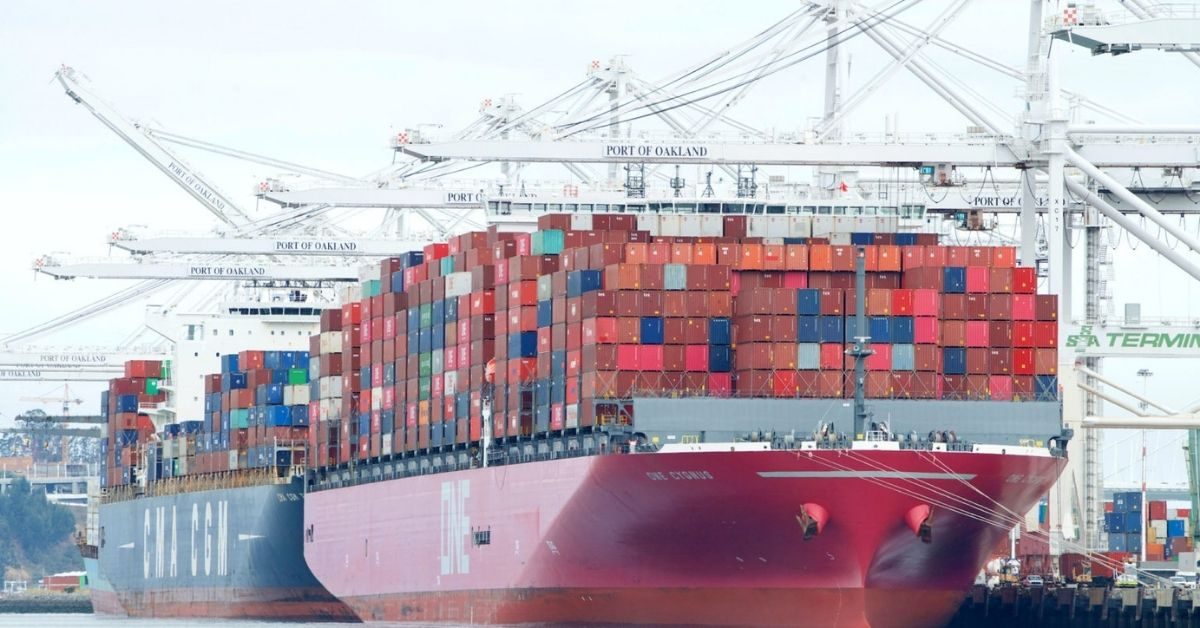The U.S.’s busiest port complex in southern California has more demand than it can handle — and that’s left smaller hubs along the nation’s coastline angling for some of that business.
After dealing with supply-chain issues of its own over the summer, California’s Port of Oakland is now ready “to be put to use to help shore up” the crisis, its Maritime Director Bryan Brandes said last month. Over in Florida, Governor Ron DeSantis has pitched the state’s 15 seaports as the relief the U.S. needs, saying local harbors “are used to operating around the clock.” And in Texas, Governor Greg Abbott launched an “Escape California” campaign aimed at attracting carriers to the Gulf Coast.
The Los Angeles-Long Beach port complex has been dealing with record-breaking backlogs since the summer that have hardly eased despite ramped-up operations and the involvement of a White House-led task force. The situation has escalated to the point where the twin ports will start fining carriers for letting their containers stay too long at the terminals from Nov. 15.
To be sure, shipping goods to alternative ports has its own supply-chain challenges. When it comes to moving cargo from China to Florida, the extra leg through the Panama Canal can sometimes add over 10 more days to the trip on top of the two weeks it usually takes to ship goods to the West Coast, according to Bloomberg Intelligence analyst Adam Roszkowski.
But with containers piling up and logjams swelling in California’s San Pedro Bay, those extra days would likely even out for cargo destined to the East Coast, Florida Ports Council President Michael Rubin said.
“If you’re trying to move it to this side of the United States and you’re parked off the coast of California, those 10 days are now being eaten up,” Rubin said by phone. “They’re probably less than what you’re paying now.”
Florida’s busiest Port of Jacksonville, known as Jaxport, is offering incentives to attract carriers by working with analysts who can develop cost-beneficial alternatives to their current routes. “We are within about a one day truck drive of nearly 100 million consumers,” said Jaxport Director Robert Peek.
So far, the port has managed to successfully glean business from Georgia’s congested Port of Savannah, with Hapag-Lloyd AG announcing in October it’s temporarily sending its calls to Jacksonville to “optimize our service portfolio.”
But attracting shipments from California’s mega-ports may be a longer shot, said Nathan Strang, director of ocean trade-lane management at logistics firm Flexport. On top of the longer shipping times, West Coast-bound carriers turning to Florida would also have to deal with more modest capacity. “Just sending everything to the East Coast isn’t quite gonna work,” Strang said.
Florida’s ports “are pretty much running at 70-80% capacity right now,” he added. “It would not take too much more cargo to tip them over.”
Meanwhile, about 400 miles north of the San Pedro Bay, the Port of Oakland is also telling carriers they have room for the overflow.
Oakland dealt with bottlenecks of its own over the summer, when about 30 ships were waiting to anchor in the San Francisco Bay due to a months-long shortage of dockworkers. It has since added about 300 employees, which helped boost the workforce by 16% and the number of ships waiting at bay has fallen to zero, according to Danny Wan, the port’s executive director.
Amid the worker shortage, some companies decided to omit Oakland from their schedule, but now they’re “realizing they overcorrected,” said Wan. The San Francisco Bay port is expecting vessel calls and cargo volume to recover toward the end of the year, but administrators say it has capacity to handle part of southern California’s spillover.
“We have all the capacity Los Angeles and Long Beach have on a smaller scale, that’s all,” Wan said.
Flexport’s Strang warned that “the difference between Oakland operating at optimal capacity and Oakland being overwhelmed is only a couple of more ships a week.” As ports everywhere hunt for more business to counter the crisis in southern California, they should be cautious about how far they can go, he said.
“These ports can drown in their own success very quickly,” Strang said.
Source : G Captain







